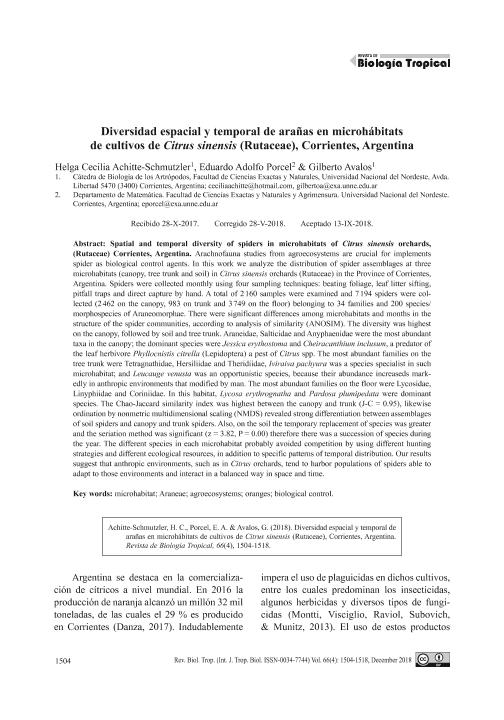Mostrar el registro sencillo del ítem
dc.contributor.author
Achitte Schmutzler, Helga Cecilia

dc.contributor.author
Porcel, Eduardo Adolfo

dc.contributor.author
Avalos, Gilberto

dc.date.available
2021-06-09T15:07:39Z
dc.date.issued
2018-12
dc.identifier.citation
Achitte Schmutzler, Helga Cecilia; Porcel, Eduardo Adolfo; Avalos, Gilberto; Diversidad espacial y temporal de arañas en microhábitats de cultivos de citrus sinensis (Rutaceae), Corrientes, Argentina; Revista de Biología Tropical; Revista de Biología Tropical; 66; 4; 12-2018; 1504-1518
dc.identifier.issn
0034-7744
dc.identifier.uri
http://hdl.handle.net/11336/133511
dc.description.abstract
Los estudios de la araneofauna en los agroecosistemasson cruciales para la implementación de las arañascomo agentes potenciales de control biológico de plagas.En este trabajo se analiza la distribución del ensamble dearañas en los microhábitats (follaje, tronco y suelo) de loscultivos de Citrus sinensis, (Rutaceae) de la Provincia deCorrientes, Argentina. Los muestreos se realizaron mensualmentemediante cuatro técnicas de captura: agitaciónde follaje, tamizado de hojarasca, pitfall y captura manual.En total se obtuvieron 2 160 muestras y 7 194 ejemplaresde arañas (2 462 en follaje, 983 en tallo y 3 749 en suelo)pertenecientes a 35 familias y 200 especies de Araneomorphae.Hubo diferencias significativas en la estructurade las comunidades de arañas de los tres microhábitats yentre los meses, según el análisis de similitud (ANOSIM).El follaje presentó mayor diversidad, seguido por el sueloy el tronco. Araneidae, Theridiidae y Salticidae predominaronen el follaje; las especies dominantes fueron: Jessicaerythostoma y Cheiracantium inclusum, esta araña es unade las principales depredadoras de las larvas de Phyllocnistiscitrella (Lepidoptera) que atacan las hojas de Citrus.En el tronco abundaron: Tetragnathidae, Hersiliidae yTheridiidae, destacándose Iviraiva pachyura, una especieespecialista en dicho microhabitat; y Leucauge venusta lacual consideramos que es una especie oportunista, debidoa que su abundancia se incrementa notablemente en sitiosmodificados por el hombre. En el suelo abundaron: Lycosidae,Linyphiidae y Coriniidae; Lycosa erythrognatha fuela especie dominante, seguida de Pardosa plumipedata. Elíndice de similitud Chao-Jaccard fue mayor entre el follajey el tronco (J-C = 0.95), asimismo el ordenamiento EscaladoMultidimencional no Métrico (NMDS) mostró una claradiferenciación de la composición de especies del suelocon respecto al follaje y al tronco. Además, en el suelohubo mayor recambio temporal de especies y el métodode seriación resultó significativo (z = 3.82, P = 0 .00) porlo tanto hubo una sucesión de especies durante el año demuestreo. Las especies en cada microhabitat probablementeevitan la competencia al utilizar distintas estrategias decaza y recursos ecológicos, además de patrones específicosde distribución temporal. Nuestros resultados sugieren quelas modificaciones del ambiente, como en estos cultivos deC. sinensis, tienden a albergar varias poblaciones de arañasque se adaptaron a dicho cambio e interactúan de maneraequilibrada en espacio y tiempo.
dc.description.abstract
Arachnofauna studies from agroecosystems are crucial for implements spider as biological control agents. In this work we analyze the distribution of spider assemblages at three microhabitats (canopy, tree trunk and soil) in Citrus sinensis orchards (Rutaceae) in the Province of Corrientes, Argentina. Spiders were collected monthly using four sampling techniques: beating foliage, leaf litter sifting, pitfall traps and direct capture by hand. A total of 2 160 samples were examined and 7 194 spiders were collected (2 462 on the canopy, 983 on trunk and 3 749 on the floor) belonging to 34 families and 200 species/ morphospecies of Araneomorphae. There were significant differences among microhabitats and months in the structure of the spider communities, according to analysis of similarity (ANOSIM). The diversity was highest on the canopy, followed by soil and tree trunk. Araneidae, Salticidae and Anyphaenidae were the most abundant taxa in the canopy; the dominant species were Jessica erythostoma and Cheiracanthium inclusum, a predator of the leaf herbivore Phyllocnistis citrella (Lepidoptera) a pest of Citrus spp. The most abundant families on the tree trunk were Tetragnathidae, Hersiliidae and Theridiidae, Iviraiva pachyura was a species specialist in such microhabitat; and Leucauge venusta was an opportunistic species, because their abundance increaseds markedly in anthropic environments that modified by man. The most abundant families on the floor were Lycosidae, Linyphiidae and Coriniidae. In this habitat, Lycosa erythrognatha and Pardosa plumipedata were dominant species. The Chao-Jaccard similarity index was highest between the canopy and trunk (J-C = 0.95), likewise ordination by nonmetric multidimensional scaling (NMDS) revealed strong differentiation between assemblages of soil spiders and canopy and trunk spiders. Also, on the soil the temporary replacement of species was greater and the seriation method was significant (z = 3.82, P = 0.00) therefore there was a succession of species during the year. The different species in each microhabitat probably avoided competition by using different hunting strategies and different ecological resources, in addition to specific patterns of temporal distribution. Our results suggest that anthropic environments, such as in Citrus orchards, tend to harbor populations of spiders able to adapt to those environments and interact in a balanced way in space and time.
dc.format
application/pdf
dc.language.iso
spa
dc.publisher
Revista de Biología Tropical

dc.rights
info:eu-repo/semantics/openAccess
dc.rights.uri
https://creativecommons.org/licenses/by-nc-sa/2.5/ar/
dc.subject
AGROECOSYSTEMS
dc.subject
ARANEAE
dc.subject
BIOLOGICAL CONTROL
dc.subject
MICROHABITAT
dc.subject
ORANGES
dc.subject.classification
Ecología

dc.subject.classification
Ciencias Biológicas

dc.subject.classification
CIENCIAS NATURALES Y EXACTAS

dc.title
Diversidad espacial y temporal de arañas en microhábitats de cultivos de citrus sinensis (Rutaceae), Corrientes, Argentina
dc.title
Spatial and temporal diversity of spiders in microhabitats of citrus sinensis orchards, (Rutaceae) Corrientes, Argentina
dc.type
info:eu-repo/semantics/article
dc.type
info:ar-repo/semantics/artículo
dc.type
info:eu-repo/semantics/publishedVersion
dc.date.updated
2021-06-07T16:08:59Z
dc.identifier.eissn
0034-7744
dc.journal.volume
66
dc.journal.number
4
dc.journal.pagination
1504-1518
dc.journal.pais
Costa Rica

dc.journal.ciudad
San José
dc.description.fil
Fil: Achitte Schmutzler, Helga Cecilia. Universidad Nacional del Nordeste. Facultad de Ciencias Exactas, Naturales y Agrimensura. Laboratorio de Biología de los Artrópodos; Argentina. Consejo Nacional de Investigaciones Científicas y Técnicas. Centro Científico Tecnológico Conicet - Nordeste; Argentina
dc.description.fil
Fil: Porcel, Eduardo Adolfo. Universidad Nacional del Nordeste. Facultad de Ciencias Exactas y Naturales y Agrimensura; Argentina
dc.description.fil
Fil: Avalos, Gilberto. Universidad Nacional del Nordeste. Facultad de Ciencias Exactas, Naturales y Agrimensura. Laboratorio de Biología de los Artrópodos; Argentina
dc.journal.title
Revista de Biología Tropical

dc.relation.alternativeid
info:eu-repo/semantics/altIdentifier/doi/http://dx.doi.org/10.15517/rbt.v66i4.30612
dc.relation.alternativeid
info:eu-repo/semantics/altIdentifier/url/https://www.scielo.sa.cr/scielo.php?script=sci_arttext&pid=S0034-77442018000401504
Archivos asociados
